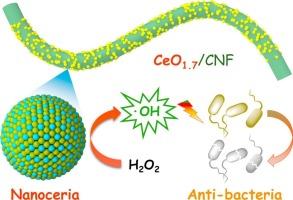Bioinspired mineralization of ultra-small ceria on cellulose nanofiber enables biocompatible and efficient nanozyme
IF 10.7
1区 化学
Q1 CHEMISTRY, APPLIED
引用次数: 0
Abstract
The escalating threat of antibiotic-resistant bacteria necessitates the exploration of alternative therapeutic strategies. Mimicking natural enzymes with artificial nanomaterials to release reactive oxygen species offers an attractive approach but is still challenged by limited catalytic activity, high production costs, and compromised biocompatibility. This work develops a bioinspired mineralization strategy for immobilizing high-density and ultra-small ceria nanoparticles onto cellulose nanofibers. The high surface-to-volume ratio of as-prepared nanoceria coupled with the aqueous processing environment facilitates the incorporation of a high Ce3+ content, significantly enhancing the peroxidase-like activity. The resulting ceria nanozyme demonstrates efficient antibacterial activity with negligible cytotoxicity. The utilization of bio-based resources and a sustainable mineralization procedure allows for the cost-effective, facile preparation of eco-friendly nanozyme products under mild conditions. This study presents a promising strategy for the rational design and large-scale fabrication of high-performance and low-cost bio-based catalysts applicable to diverse targeted catalytic applications.

纤维素纳米纤维上超小型铈的生物启发矿化技术实现了生物兼容的高效纳米酶
抗生素耐药细菌的威胁不断升级,因此有必要探索替代治疗策略。用人造纳米材料模仿天然酶来释放活性氧是一种极具吸引力的方法,但催化活性有限、生产成本高、生物相容性差等问题仍然是其面临的挑战。这项研究开发了一种生物启发矿化策略,将高密度、超小型铈纳米粒子固定在纤维素纳米纤维上。制备的纳米铈具有较高的表面积比,再加上水性加工环境,使得Ce3+含量较高,从而显著增强了过氧化物酶样活性。由此产生的铈纳米酶具有高效的抗菌活性,细胞毒性几乎可以忽略不计。利用生物资源和可持续的矿化程序,可以在温和的条件下制备出具有成本效益的环保型纳米酶产品。这项研究为合理设计和大规模制造高性能、低成本的生物基催化剂提供了一种可行的策略,适用于各种目标催化应用。
本文章由计算机程序翻译,如有差异,请以英文原文为准。
求助全文
约1分钟内获得全文
求助全文
来源期刊

Carbohydrate Polymers
化学-高分子科学
CiteScore
22.40
自引率
8.00%
发文量
1286
审稿时长
47 days
期刊介绍:
Carbohydrate Polymers stands as a prominent journal in the glycoscience field, dedicated to exploring and harnessing the potential of polysaccharides with applications spanning bioenergy, bioplastics, biomaterials, biorefining, chemistry, drug delivery, food, health, nanotechnology, packaging, paper, pharmaceuticals, medicine, oil recovery, textiles, tissue engineering, wood, and various aspects of glycoscience.
The journal emphasizes the central role of well-characterized carbohydrate polymers, highlighting their significance as the primary focus rather than a peripheral topic. Each paper must prominently feature at least one named carbohydrate polymer, evident in both citation and title, with a commitment to innovative research that advances scientific knowledge.
 求助内容:
求助内容: 应助结果提醒方式:
应助结果提醒方式:


